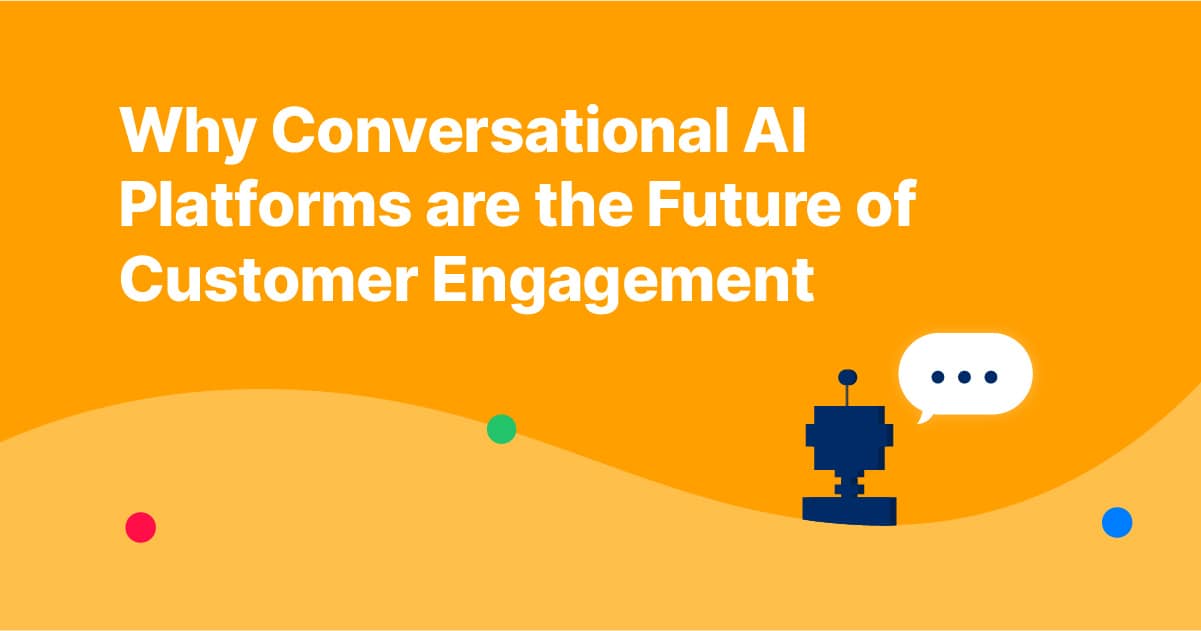Picture this: you’re walking into a busy store, and you’re immediately greeted by a friendly sales associate. They ask if you need any help finding what you’re looking for. They’re attentive, knowledgeable. And they make you feel like you’re the most important customer in the store. It’s a great experience, right?
Now, imagine if you could replicate that same level of personalized service and attention in every customer interaction – whether it’s online, on the phone, or somewhere else. That’s where conversational AI platforms come in.
Think of conversational AI as your brand’s virtual sales associate. It’s always on, always ready to help, and it can engage with customers in a way that feels natural and human-like. Whether it’s answering common questions, providing product recommendations, or even processing orders, conversational AI can handle it.
But conversational AI isn’t just a fancy chatbot – it’s the future of customer engagement. With the rise of voice assistants like Alexa and Siri, customers are becoming more comfortable with conversing with machines. And as AI technology continues to evolve, conversational AI will only become more sophisticated and intuitive.
So, if you want to stay ahead of the curve and provide the best possible customer experience, it’s time to invest in a conversational AI platform. Because let’s face it – in today’s digital age, the customer experience is everything. And with conversational AI, you can provide a level of service that’s on par with that friendly sales associate you met in the store.
What is a conversational AI platform?
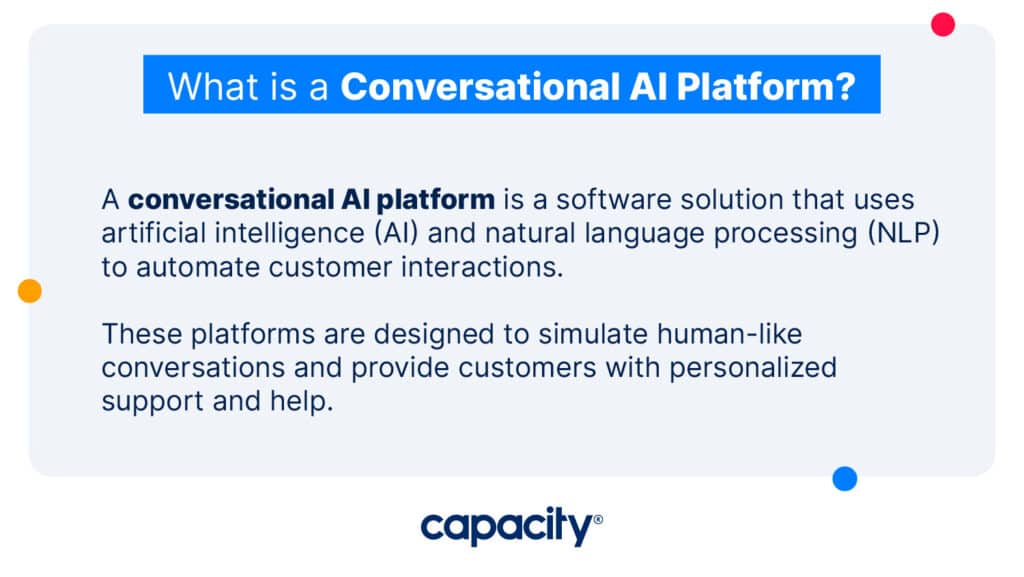
A conversational AI platform is a software solution that uses AI and NLP to automate customer interactions. They simulate human-like conversations and provide customers with personalized support and help.
The platforms can include several different AI tools. Examples include chatbots, voice assistants, and virtual agents. You can integrate them with a bunch of different customer engagement channels. This comprises websites, mobile apps, social media platforms, and messaging services.
Four use cases of a conversational AI platform in customer service
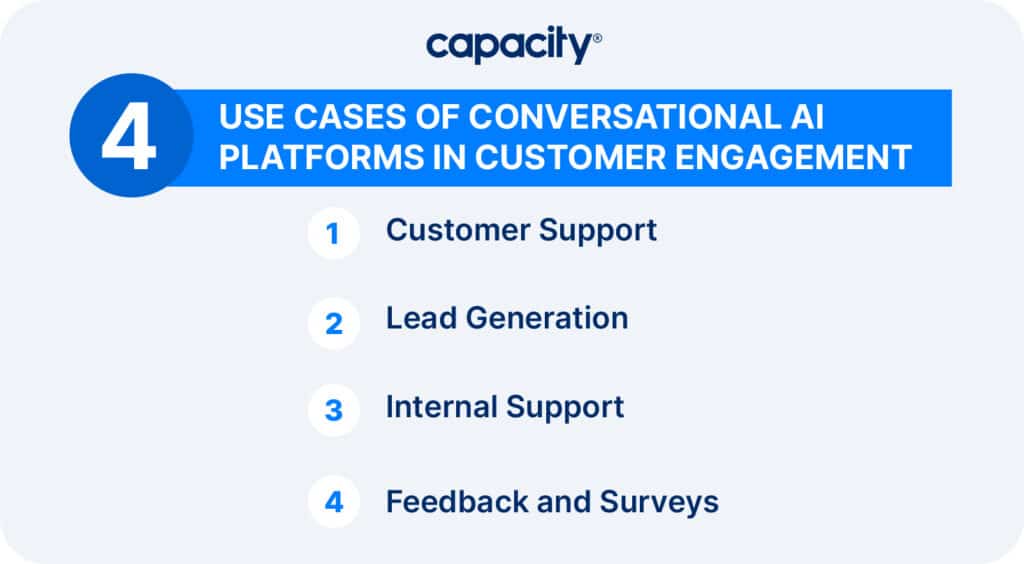
Customer support
As technology continues to evolve, so does the way we interact with each other. And so AI platforms have become a game-changer for businesses. They can understand human language, which means your customers aren’t left on hold. What’s more, customers don’t have to deal with (frustrating) automated IVR menus.
Chatbots can provide 24/7 support to customers. And they can significantly reduce the workload on customer support teams. Support agents can then focus on higher-priority tasks.
Lead generation
Another use case for conversational AI platforms is lead generation. Your chatbot can have full conversations with prospects. It can ask targeted questions and even qualify opportunities. You can get more leads and improve your conversion rates by adding a bot.
Internal support
You can use conversational AI platforms to improve your internal support systems. Employees can ask questions, like HR policies or product demos, and get answers in seconds. And they can do so without having to ask a colleague. At Capacity, we have our tech integrated into our Slack instance. So when I started, I was able to ask things like, “How do I enroll in benefits” and “Where do I take the security quiz”. Our HR team also sent out a 30/60/90-day survey through it, too.
Feedback and surveys
Speaking of surveys, you can use your platform to collect feedback, both internally and externally. The bot can ask customers for their opinions and collect then analyze the data. This gives you insight into their preferences. And that then lets you make more informed decisions.
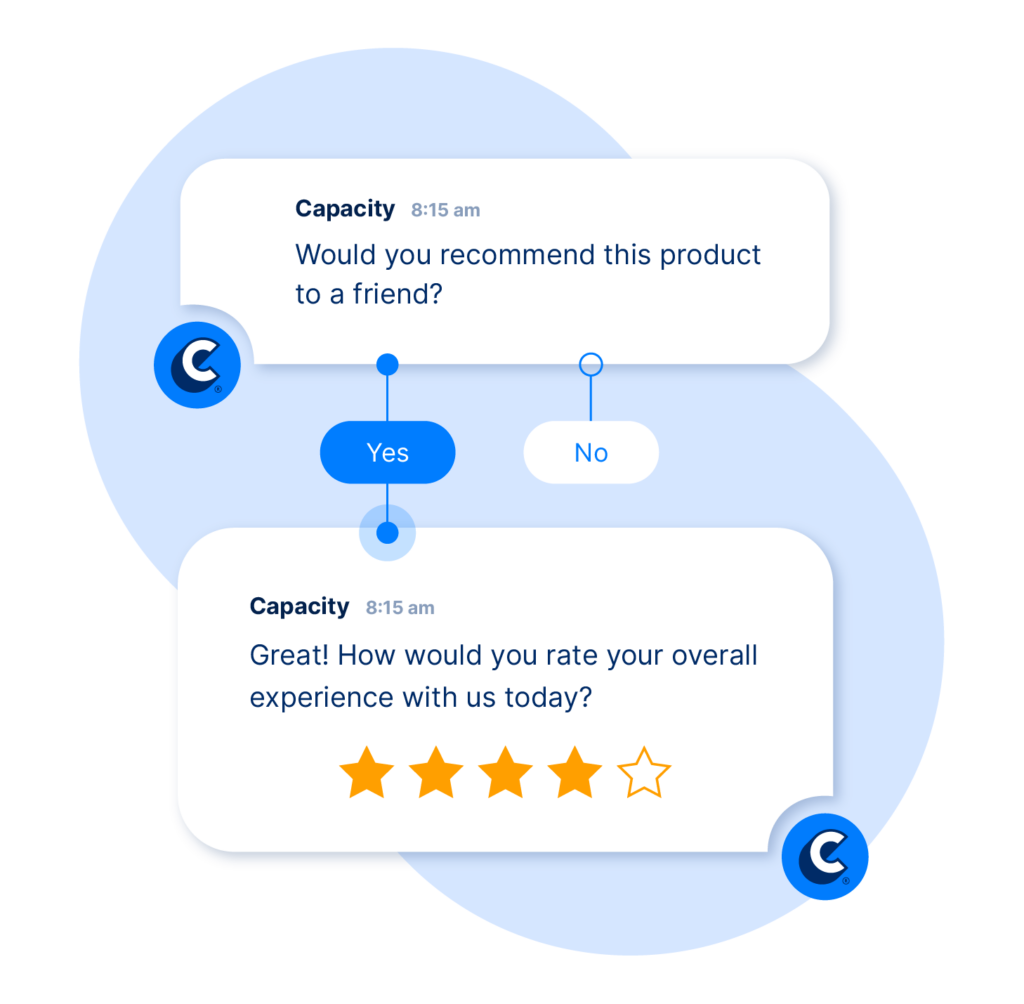
The Benefits of a Conversational AI Platform
There are numerous benefits to using a conversational AI platform in customer engagement, including:
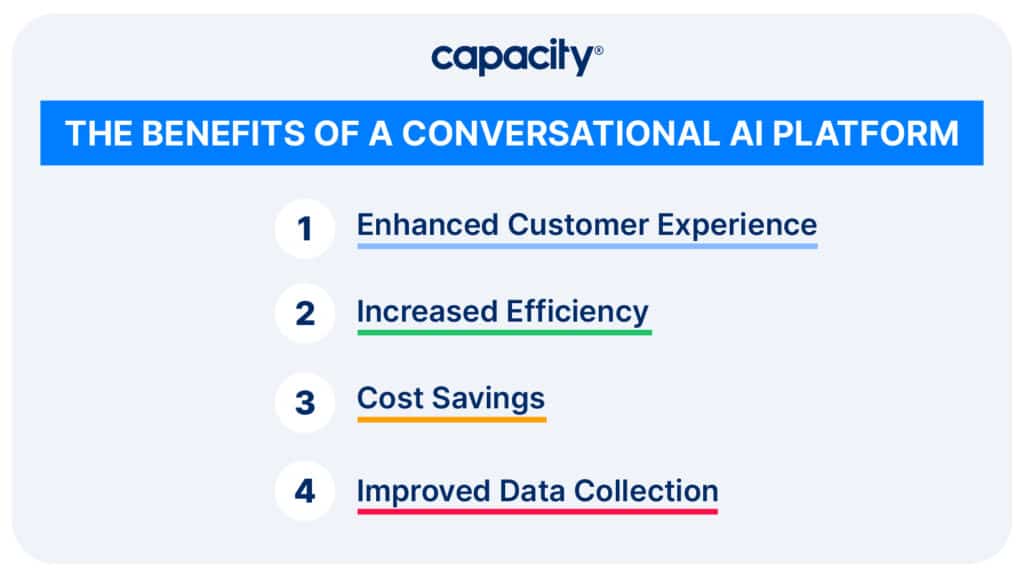
Enhanced customer experience
Conversational AI platforms provide 24/7 support, letting customers get help anytime, anywhere. They can quickly and efficiently handle customer inquiries. And that means they’re getting totally personalized solutions that boost their experience.
Increased efficiency
You can reduce your team’s workload by adding a conversational AI platform. Seriously! Because the bot can answer questions and have real conversations, your agents don’t have to. Then, your team’s free to focus on issues that actually need their brain power and attention.
Cost savings
By automating customer interactions, a conversational AI platform can reduce support costs. This is super helpful for small and medium-sized businesses. Those teams in particular may not have the resources to maintain a bunch of support employees.
Improved data collection
Make data-driven decisions from the information your bot collects. For instance, you can get data on preferences, pains, and general feedback. Those can all inform your product development and go-to-market strategies.
How does a conversational AI platform work?
Conversational AI platforms use a combination of NLP, machine learning, and other technologies to simulate human-like conversations. Here’s a step-by-step breakdown of how they work:
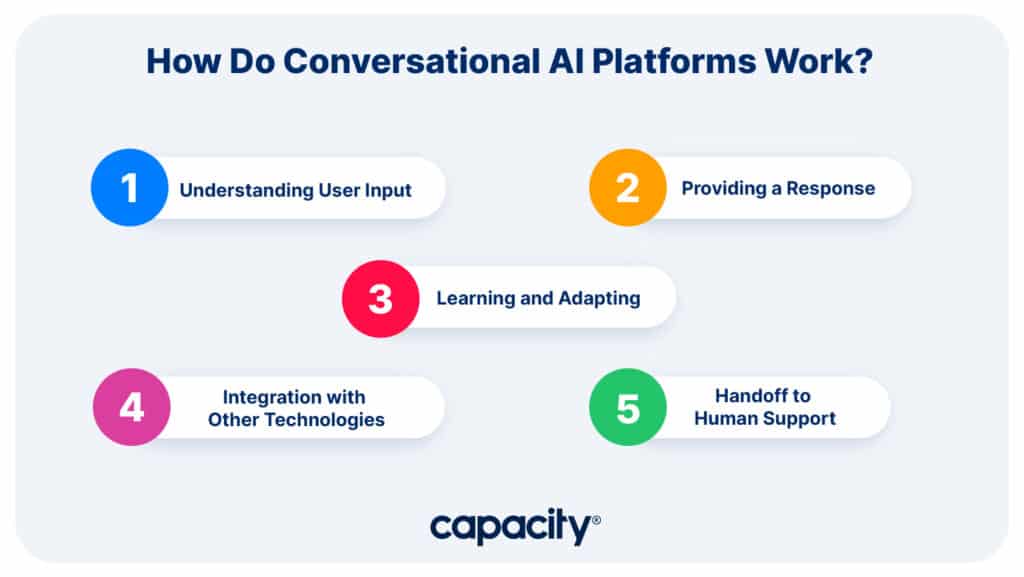
Step 1: Understanding User Input
When customers interact with a conversational AI platform, an NLP engine analyzes their input to understand their intent. This involves identifying keywords, entities, and sentiment to determine the customer’s needs.
Step 2: Providing a Response
Once the platform has understood the customer’s intent, it generates a personalized and relevant response. The answer can be in the form of text, voice, or other media.
Step 3: Learning and Adapting
Conversational AI platforms use machine learning algorithms to improve their responses continually. They learn from previous customer interactions. And then they find patterns and adjust their responses to better serve customers’ needs.
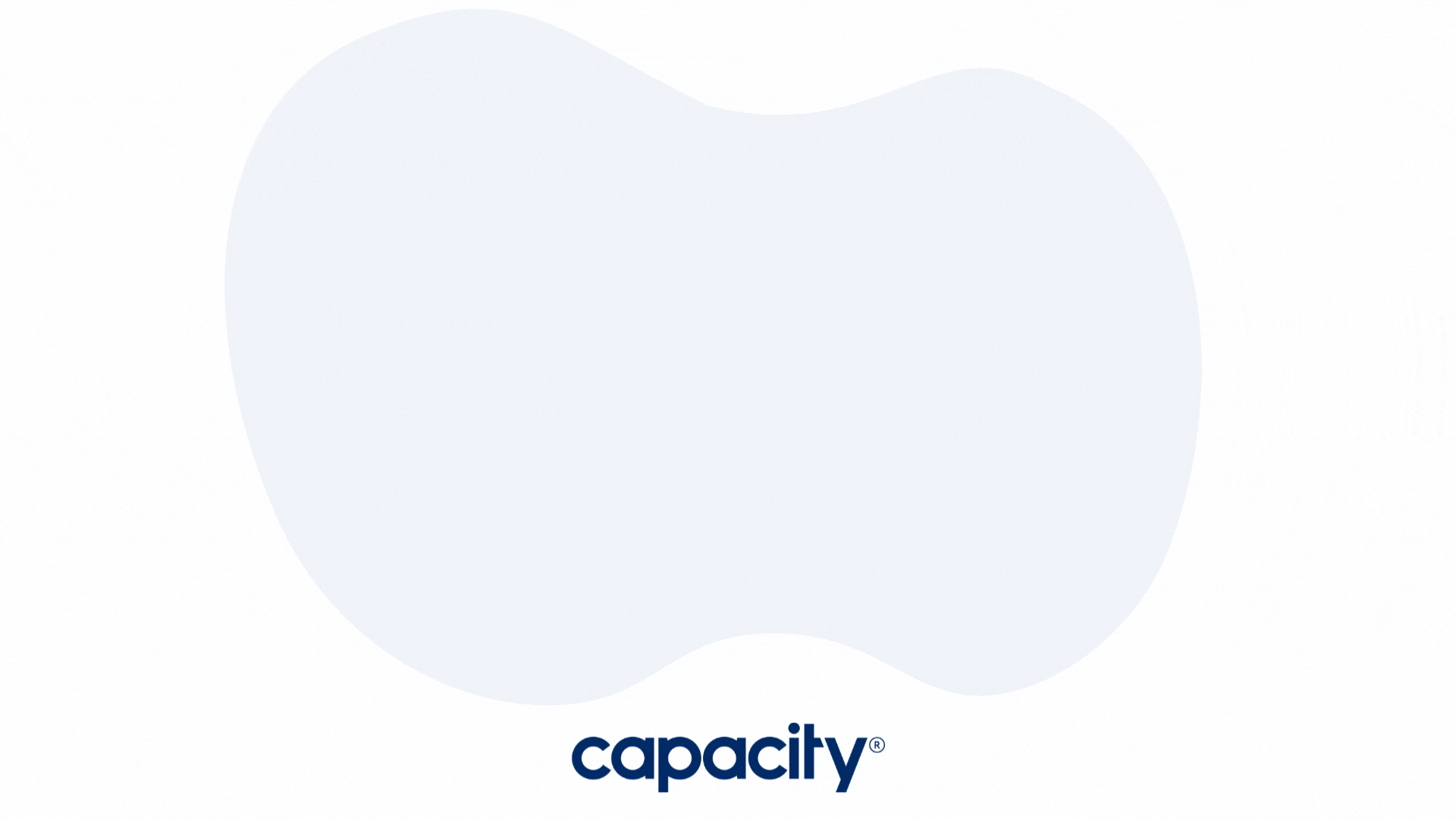
Step 4: Integration with Other Technologies
Connect your conversational AI platform with the other tech you’re already using. By adding it to your CRM, marketing software, or analytics tool, you’ll be able to have better experiences and more data in one place.
Step 5: Handoff to Human Support
In some cases, the conversational AI platform may not be able to address the customer’s needs fully. So, you’ll want the platform to hand off the conversation to a human support agent. But, they’ll need all the relevant context and information to assist the customer.

Automate Your Work
Capacity’s enterprise AI chatbot can help:
- Answer FAQs anytime, anywhere
- Find relevant documents within seconds
- Give surveys and collect feedback
Overcoming challenges in conversational AI: understanding limitations and improving accuracy
Conversational AI platforms have come a long way in recent years. They’re insanely helpful and give businesses new ways to engage and support customers. But, you should still address the challenges for accuracy and effectiveness.
Here are some key challenges and strategies for overcoming them:
1. Language understanding
One of the biggest challenges for conversational AI platforms is understanding language accurately. Customers may use colloquialisms, slang, or complex sentence structures. All those can be tough for AI to interpret.
To avoid misinterpretations, train your bots on a wide variety of language inputs and dialects. They should also be regularly updated to reflect changes in language usage.
2. Personalization
Customers today expect personalized experiences, and conversational AI platforms are no exception. But, personalizing conversations at scale can be challenging.
This is why it’s so helpful to connect your conversational AI platform and existing tech. You’ll give your bot more access to data so they give more relevant and targeted responses.
3. Contextual understanding:
You need your platform to understand the context of a conversation so it can answer appropriately. For instance, it should recognize when someone asks for info vs making a complaint.
To improve contextual understanding, train your bots on different conversation scenarios. And then use machine learning algorithms to improve their accuracy continually.
4. Handling complex queries:
While conversational AI platforms can handle simple queries, they may struggle with more complex or technical questions.
To overcome this challenge, consider implementing a hybrid model. That way the AI handles more straightforward queries and then human agents take more complex ones.
5. Integration with other technologies:
Conversational AI platforms should be integrated with other CRM systems and analytics tools.
This lets them to access relevant data sources and provide more personalized and effective customer responses.
Best conversational AI platform software
There are a ton of conversational AI platforms on the market, each with unique features and capabilities. Here are some of the best conversational AI platform software options:
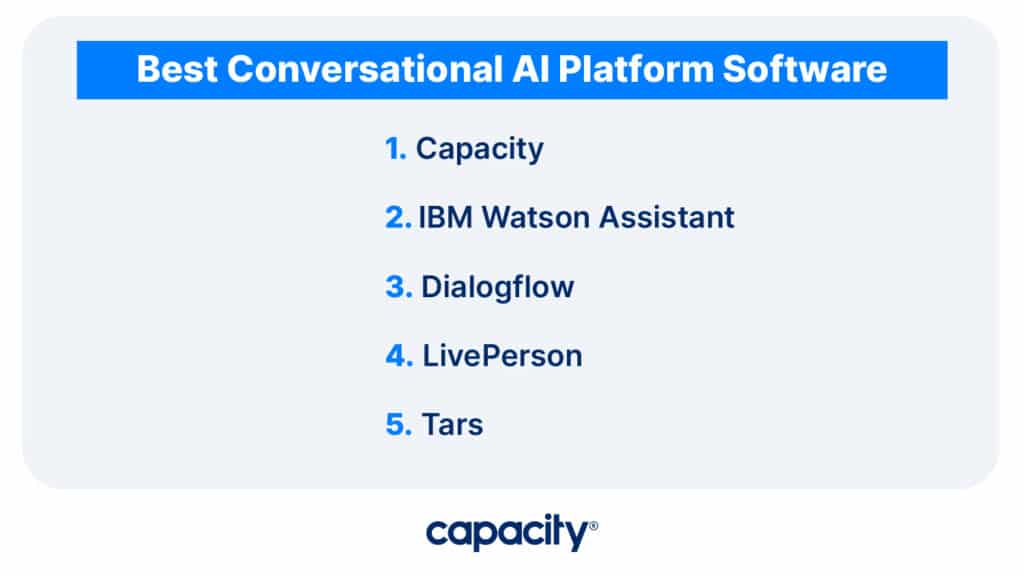
1. Capacity
Capacity is our AI-powered support automation platform. We built it to help you automate all your support and business processes.
It’s a low-code platform that’s accessible through conversational AI. But we also have powerful workflow automation, a robust developer platform, and a flexible database that you can deploy anywhere.
With Capacity, you can connect your entire tech stack to answer questions. And then, you can automate repetitive support tasks and build solutions to any business challenge.
Key Features:
- All-in-one helpdesk
- Low-code workflows
- User-friendly knowledge base
- Conversational interface
- Powerful workflow automation suite
- Robust developer platform
- Flexible database
2. IBM Watson Assistant
IBM Watson Assistant is a highly flexible platform. It works by understanding and analyzing unstructured data, like images and videos.
Key Features:
- Multi-channel support
- Customizable and flexible
- Ability to understand and analyze unstructured data
- Integration with other IBM Watson services
- Robust analytics and reporting capabilities
3. Dialogflow
Dialogflow is a Google-owned conversational AI platform. It lets you build and deploy chatbots and virtual assistants across several channels. It integrates natively with Google’s NLP technology. And that means it can understand complex user requests and give more accurate responses.
Key Features:
- Multi-channel support
- Google’s advanced NLP technology
- Built-in integrations with popular messaging platforms
- Customizable and flexible
- Analytics and reporting capabilities
4. LivePerson
LivePerson is a conversational AI platform that provides human-like conversations with customers. It transfers conversations between AI and humans, which lets customers get the exact care they need.
Key Features:
- Human-like conversations with customers
- Seamless transfer of conversations between AI and human agents
- Multi-channel support
- Integration with popular messaging platforms
- Advanced analytics and reporting capabilities
5. Tars
Tars is a conversational AI platform. It lets businesses to create and deploy chatbots and virtual assistants without coding. Its drag-and-drop interface makes it easy to customize and deploy fast.
Key Features:
- No-coding required
- Drag-and-drop interface for easy customization
- Multi-channel support
- Robust analytics and reporting capabilities
- Integration with popular messaging platforms
See why over 1200+ companies work with Capacity’s conversational AI platform. Try it for free today!


